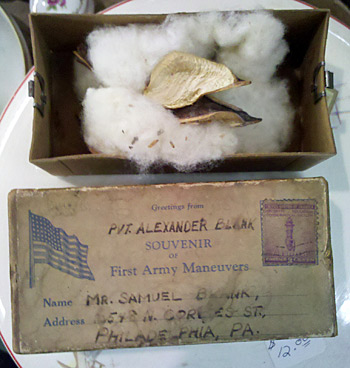Auction Finds: Cotton boll is soldier's 1941 gift from South | |
| Cotton boll is soldier's 1941 gift from South Posted: 07 Apr 2014 05:58 AM PDT Not another wad of handpicked cotton, I thought to myself, cringing at the sight before me as I approached the auction table. It seemed that unprocessed cotton was becoming a staple at auctions, but perhaps it was my being overly sensitive about seeing it. I first encountered cotton for fun during a conversation a few years ago at the home of a friend’s sister, who knew someone who had planted some cotton to be used for decoration. It was a strange notion to me that black folks would plant and pick cotton for no good reason – considering our history with the stuff. Another time, I found a small bundle of cotton being sold at auction. This cotton boll was different: It was a gift, inside a box with an address and a soldier’s name, and had been mailed with a 3-cent national defense stamp to an address in Philadelphia:
The cotton was packed by a company in Darlington, SC, and the box carried slogans and logos. On one side was the silhouette of a little girl with a young child on her hip and the slogan "A cotton boll from the fields of snowy white." Snowy white, I presumed, referred to the color of cotton. On the other side was a log cabin along with the slogan "A Breath of Dixie." This soldier, who may not have seen fields of snowy-white cotton before, felt compelled to send some back to Philadelphia as a keepsake for his time in the Carolinas. And he was not likely the only one. Alexander Blank was in the South as part of the First Army Maneuvers – also called the Carolina Maneuvers – which were part of one of the largest training exercises for U.S. Army personnel and equipment ever conducted. The training occurred in October and November of 1941, aimed at readying the military for what most saw as the eventual pull of the United States into World War II. Similar maneuvers had been conducted in Louisiana in the summer of 1941 – called the Louisiana Maneuvers – pitting the Second Army and Third Army against each other. These types of maneuvers had been going on since 1939 but on a smaller scale. The war had started in Europe in 1939, and by 1940, Adolf Hitler and the Nazis had taken Poland and much of western Europe, with their sights on France and England. The United States had mobilized its National Guard and Reserves to augment what was then more a ragtag than professional cadre of fighting troops. The U.S. Army was poorly trained or not trained, and lacked combat experience. So, the Army contracted for trespassing rights on huge swatches of farmland in North and South Carolina to conduct the massive training program. Most farmers were obliging as the countrysides filled up with men engaged in mock combat, while others posted "Off limits to troops" signs to prevent trespassing. Red Team and Blue Team soldiers of the First Army fought against each other on the ground and in the air in an area that encompassed central and eastern parts of the two states. These war games involved half a million troops in both areas of the country, about one third of the Army. In my research, I came across photos of African American soldiers who were also enlisted in both the Carolina and Louisiana Maneuvers. The maneuvers ended in late November, just before the Japanese bombed Pearl Harbor on Dec. 7 and the United States entered the war. Subsequent field maneuvers were conducted in the country. The boll of cotton at auction was one entrepreneur’s money-making venture. With about 350,000 soldiers in the Carolinas, vendors, I’m sure, were out in force selling reminders of their adventures in the towns and fields. The South Carolina Military Museum in Columbia has maps, photos and other artifacts from the exercises, including a purple pillow inscribed with a poem for a soldier’s mother. "This is just an example of the many trinkets and keepsakes peddled by local vendors looking to cash in on the military's presence," the museum noted. I found another such pillow offered for sale on eBay, along with panoramic photos. An antiques shop was selling two pennants ($35 and $40). Among the memorabilia left behind by soldier was a pin-back button from the maneuvers.
No related posts. |
| Google Inc., 20 West Kinzie, Chicago IL USA 60610 | |



No comments:
Post a Comment